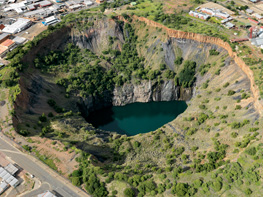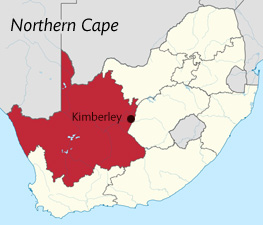Geography and climate
Northern Cape province, South Africa
Northern Cape: quick facts
- Capital: Kimberley
- Languages: 53.8% Afrikaans, 33.1% Setswana
- Population: 1 145 861 (2011)
- Share of South Africa's population: 2.2%
- Area: 372 889 square kilometres
- Share of South Africa's total land area: 30.5%
The land and its people
With a total area of 372 889 square kilometres, the Northern Cape is takes up 30.5% of South Africa's land area, with a population of 1.15-million people. Just over half of the population speak Afrikaans, with other languages being Setswana, isiXhosa and English. The last remaining true San Bushman people live in the Kalahari area of the Northern Cape. The area, especially along the Orange and Vaal rivers, is rich in San rock engravings. A good collection can be seen at the McGregor Museum in Kimberley. The province is also rich in fossils. Apart from a narrow strip of winter rainfall area along the coast, the province is a semi- arid region with little rainfall in summer. The weather conditions are extreme – cold and frosty in winter, with extremely high temperatures in summer. The largest part of the province falls within the Nama-Karoo biome, with a vegetation of low shrubland and grass, and trees limited to water courses. The area is known worldwide its spectacular annual explosion of spring flowers which, for a short period every year, attracts thousands of tourists. This biome contains a number of fascinating plants, including the elephant's trunk (halfmens or "half-man"), tree aloe (kokerboom) and a variety of succulents. The province has a wealth of national parks and conservation areas. The Kgalagadi Transfrontier Park, Africa's first cross-border game park, joins South Africa's Kalahari Gemsbok National Park to the Gemsbok National Park in Botswana. It is one of the largest conservation areas in southern Africa, and one of the largest remaining protected natural ecosystems in the world. The park provides unfenced access to a variety of game between South Africa and Botswana, over its land area of more than 3.6 hectares. The Ai-Ais Richtersveld Transfrontier Conservation Park spans the border with Namibia, with some of the most spectacular scenery of the arid and desert environments in southern Africa. Bisected by the Orange River, it comprises the Ai-Ais Hot Springs Game Park in Namibia, and the Richtersveld National Park in South Africa. Distinctive features include the Fish River Canyon – often likened to the Grand Canyon in the US – and the Ai-Ais hot springs. Nowhere is the Orange River more impressive than at the Augrabies Falls, which ranks among the world's greatest cataracts on a major river. The 19 separate falls cascade over a granite plateau, dropping a total of 191 metres to a 43-metre-deep pool gouged out by the force of the water.Industry
The Northern Cape's low population and arid conditions impact economic activity in the province, which contributes only 2% to South Africa's GDP. Its principal industries are mining (including quarrying) and agriculture. The Northern Cape mining industry makes up nearly 7% of South Africa's total mining value, and contributes 23.4% to the province's total economy. Its farmers contribute 6.1% to South African agriculture, but only make up 6.6% of the province's economy.Agriculture
Given the province's dry conditions and dependence on irrigation, many Northern Cape farmers are branching out into value-added activities such as game farming. Food production and processing for the local and export market is also on the uptick. Underpinning the growth and development plan of the province are the investment projects that link up with the existing plans of the Namaqua Development Corridor. The focus is on the beneficiation and export of sea products. The economy of a large part of the Northern Cape, the interior Karoo, depends on sheep-farming, while the karakul-pelt industry is one of the most important in the Gordonia district of Upington. The province has fertile agricultural land. In the Orange River Valley, especially at Upington, Kakamas and Keimoes, grapes and fruit are cultivated intensively. Wheat, fruit, peanuts, maize and cotton are produced at the Vaalharts Irrigation Scheme near Warrenton. SouthAfrica.info reporter, incorporating material from the South African Yearbook Updated: 2 November 2015
Would you like to use this article in your publication or on your website? See: Using SouthAfrica.info material
 The Big Hole in the Northern Cape capital of Kimberley is an open-pit diamond mine dug out between 1871 and 1914. Reaching a depth of some 215 metres deep, it is said to be the largest hand-excavated hole in the world. (Image: Brand South Africa)
The Big Hole in the Northern Cape capital of Kimberley is an open-pit diamond mine dug out between 1871 and 1914. Reaching a depth of some 215 metres deep, it is said to be the largest hand-excavated hole in the world. (Image: Brand South Africa)

Related links
Related articles
South Africa's provinces
Did you know?
CLEAR SKIES AND SPACE SCIENCE
A remote location and lack of people make the Northern Cape night skies the clearest in the country. Minimal light pollution from human settlements means perfect conditions for observing the heavens.
The Southern African Large Telescope - known as SALT - near the town of Sutherland is the largest telescope in the southern hemisphere and among the 10 biggest in the world, with a hexagonal mirror array 11 metres in diameter. SALT allows scientists to see distant stars, galaxies and quasars a billion times too faint to be visible to the naked eye – as faint as a candle's flame at the distance of the moon.
The Northern Cape has also been chosen to co-host one of the biggest and most sophisticated scientific instruments in the world, the Square Kilometre Array – a future generation international radio telescope that will allow astronomers to probe the early evolution of our galaxy - and perhaps even find evidence of extraterrestrial life.
A remote location and lack of people make the Northern Cape night skies the clearest in the country. Minimal light pollution from human settlements means perfect conditions for observing the heavens.
The Southern African Large Telescope - known as SALT - near the town of Sutherland is the largest telescope in the southern hemisphere and among the 10 biggest in the world, with a hexagonal mirror array 11 metres in diameter. SALT allows scientists to see distant stars, galaxies and quasars a billion times too faint to be visible to the naked eye – as faint as a candle's flame at the distance of the moon.
The Northern Cape has also been chosen to co-host one of the biggest and most sophisticated scientific instruments in the world, the Square Kilometre Array – a future generation international radio telescope that will allow astronomers to probe the early evolution of our galaxy - and perhaps even find evidence of extraterrestrial life.






